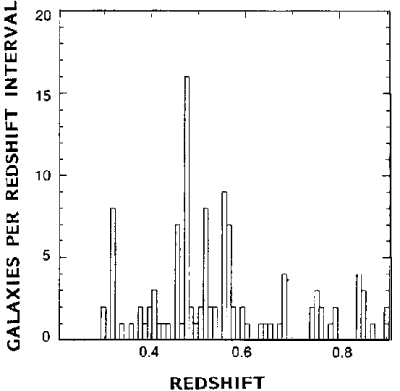 |
Science Frontiers ONLINE No. 109: Jan-Feb 1997 |
|
|
Too Much Order In The Early Cosmos
Astronomers are becoming accustomed to the idea that many nearby galaxies are concentrated in spherical shells separated from one another by about 400 million light years. This onion-skin geometry is inferred from the fact that galactic red shifts cluster around specific values; that is, they are quantized. Since red shifts are held to be proportional to distance in the expanding universe paradigm: Voila! We have shells! This evidence of nearby cosmic order does not seriously disturb cosmologists, because in the nearby galaxies we are seeing that portion of the universe that is billions of years old. In other words, nearby there has been enough time for some degree of order to have evolved out of the primordial chaos of the Big Bang.
Now though, "deep" surveys of galaxies, looking much farther back in time, still show clustered red shifts -- not the expected increasing chaos required by theory. Although the surveys are incomplete, astronomers are discomfited by this early lumpiness. Their theories say that there was not enough time for galaxies to organize themselves into sheets, shells, and skeins. If further "deep" probings of the cosmos confirm this redshift clustering, we may need a new evolutionary scenario. Good bye Big Bang and expanding universe!
(Vogel, Gretchen; "Goodness, Gracious, Great Walls Afar," Science, 274:343, 1996. Vergano, D.; "New Evidence of Cosmic Architecture," Science News, 150:239, 1996)
In a related news item, Mexican scientists have proposed that most of the matter in the universe (that elusive "dark" matter) may exist in the form of particles they dub "dilatons." Dilatons might also explain the formation of the aforesaid galactic shells.
"The Mexican researchers have explored a situation in which G [the gravitational constant], instead of becoming fixed after gravity separated from the other forces [after the Big Bang], has continued to oscillate by a few per cent. They have found that the mass of dilatons required to allow G to vary in this way could account for all the Universe's dark matter."
A consequence of an oscillating G would be a varying rate of expansion for the universe -- a sort of ebb and flow of the whole cosmos. One can then visualize galaxies gradually clustering together into shells much as sand particles drift into ripples under the influence of waves along a beach.
(Parsons, Paul; "Weird Matter Makes Gravity Wobble," New Scientist, p. 19, October 5, 1996)
 |
Clustering of distant galaxies |